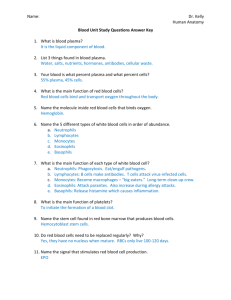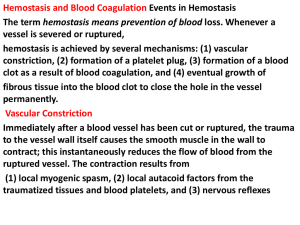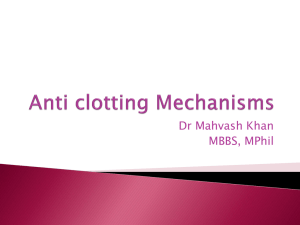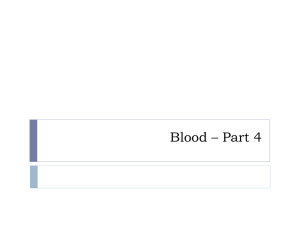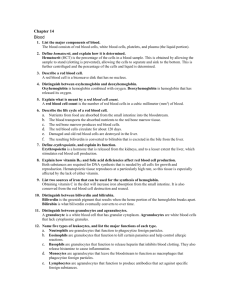FIBRIN_Final Model Project-PHYS 053-001
advertisement
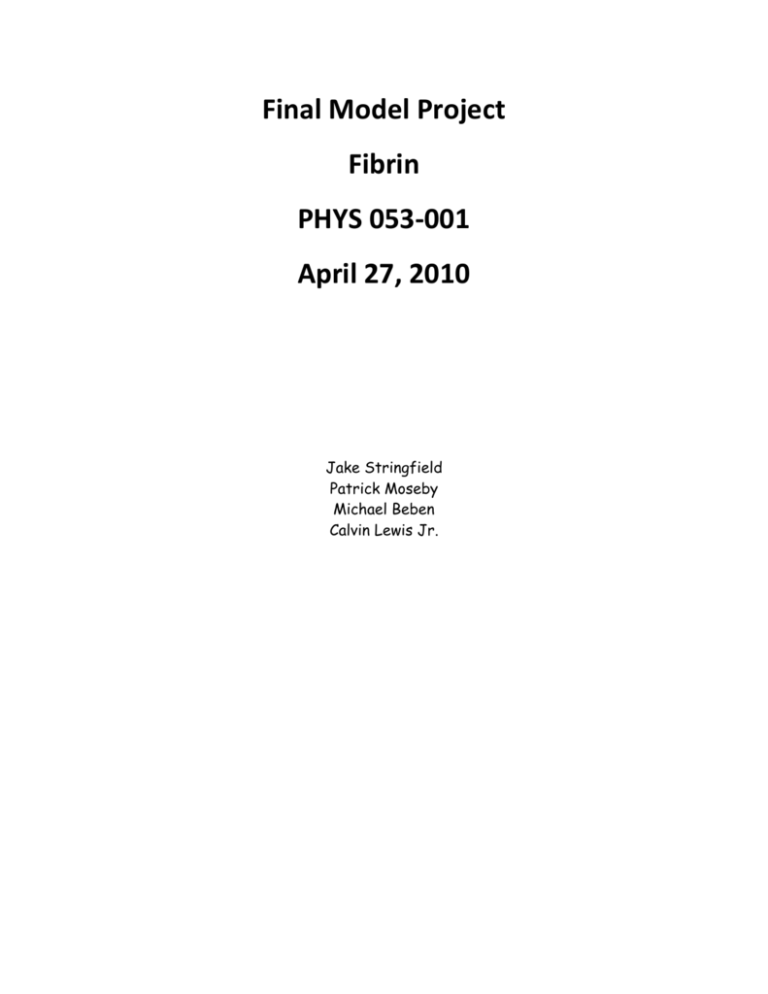
Final Model Project Fibrin PHYS 053-001 April 27, 2010 Jake Stringfield Patrick Moseby Michael Beben Calvin Lewis Jr. Part A: Clot Formation in Human Blood This project is focused on describing and modeling the overall process of hemostasis in humans, with a particular focus on the role that the protein fibrinogen plays in the formation of thrombi. Understanding this process is important for multiple reasons. This is a process that occurs in a similar way in almost every mammal, so it is clear that this is a very essential process for life: without clotting, blood would escape through holes worn in vessel walls, and oxygen would not be delivered to the body, leading to death. While the process of coagulation is well conserved in most mammals, the specifics of the human clotting are of most scientific interest, because of the medical applications that a better knowledge of clotting could advance. It is important that all processes involved in clot formation are functioning properly; a mutation that inactivates a single clotting factor can lead to hemophilia, while overactive clotting mechanisms can lead to heart attack, stroke, or other embolism. Besides the important medical significance that this process has, an understanding of the mechanisms of clotting will be valuable to pure science, with relevance to nanotechnology, biology, and the physics of protein mechanics. The blood is a very complex solution of ions, chemical messengers, cells, and proteins. Blood carries oxygen, nutrients, and water to every cell in your body, sustaining their metabolism, and keeping them alive. It helps to fight off infections, keeping the body healthy. It removes waste and toxins from cells and safely disposing of them. All of these crucial functions depend on blood being delivered, and this is why hemostasis is so important. The proteins responsible for clotting, collectively referred to as clotting factors, are in constant circulation in the blood, along with many other substances. However, all of these proteins are inactive in normal blood. Certain proteins, called subendothelial proteins, contained behind the endothelium, the one-cell-thick wall of blood vessels, enter the blood stream through an injury to the endothelium. The other key component in blood clot formation are the platelets, cell fragments to which, along with their role in clotting, produce growth factors, that speed healing in regions where the blood vessels are damaged. All of these components work together in a complex way to form clots. When endothelial cells are ruptured, subendothelial proteins are exposed to the blood stream. These proteins, including tissue factor and von Willebrand Factor, begin a cascade of conformational changes in the clotting factors present in the blood stream, as well as activating nearby platelets. The newly activated platelets, which begin as roughly spherical cell fragments, will also change shape, growing protrusions that help facilitate their binding to each other, to the area of the clot, and to clotting factors. Platelets then make up the primary hemostasis, a plug formed from activated platelets at the site of the rupture, held together by various clotting factors. At this point the secondary hemostasis, consisting mainly of clotting factor 1, fibrinogen, will begin to form. The cascade of clotting factors will at this point lead to a surge of thrombin, which activates the fibrinogen. Fibrinogen will then bind to itself, forming fibrin, a network of strong and stretchy fiber that will seal the clot securely. As with all proteins, the structure of fibrinogen is key to its function. Fibrinogen is a fibrillar protein that polymerizes, as described above, to form a viscoelastic gel. Activation of fibrin severs the ends of the BβN domain, exposing sticky knobs that can bind to adjacent fibrinogen molecules at their holes in their D region. This results in a strong staggered formation of fibrinogen molecules within the fiber they make up, and the lack of rigidity in the BβN domain is likely one of the ways that fibrin stretches. The αC domain also plays a role in binding and stretching, but it is less understood. The coiled coil domain that makes up most of the length of the protein is also believed to be involved in stretching. All together, the structure of the protein can, in some cases, allow stretching by a factor of six before breaking, making fibrin the most flexible biological polymers yet. Proteins stretch when strain uncoils them from their preferred, most stable state. Shown above is the crystalline structure of fibrinogen, but under stress certain interactions would be broken in order to accommodate the forces applied to the molecule. One of the main interactions that will be broken is hydrogen bonds. These bonds are based upon magnetic interactions between the hydrogen atoms bonded to nitrogen atoms, and oxygen atoms. Because of the high electronegativity of both nitrogen and oxygen, the hydrogen atoms will have most of their electron cloud stolen from them, giving them a slight positive charge. Likewise the oxygen atoms will have slightly more electron density, and will have a slight negative charge. The interactions between these atoms are analogous to natural magnets, because they can be pulled apart and reformed if stress is applied and released. As the protein is stretched, hydrogen bonds will break until eventually only the carbon-carbon-nitrogen backbone resists, at which point it will take far more force to stretch the molecule any further. In this way force will be distributed to adjacent fibrinogen molecules in the clot, allowing the fibrin to have enough strength and flexibility to function in the highly dynamic environment of pulsing blood. Part B: Model #1 What We Are Modeling Our first model was of a blood clot, formed in a small vessel. We sought to represent the function of fibrin and platelets in the process of forming a clot. Our model clot is different from regular clots in that usually the clot forms on a small area of the vessel where a tear has occurred. Our model shows a vessel that is completely occluded.(This is when a thrombus occurs; if that thrombus breaks free, it forms an embolus.) Materials and Reasons We built the “vessel wall” by making a geometrically approximate topless and bottomless cylinder out of plastic building beams (they are like K-Nex). The primary reason we chose to use this material for the vessel wall was that it was strong enough to withhold the tension of the bands (our fibrin) while still providing a basically cylindrical shape, which is supposed to be analogous to a cylindrical blood vessel. Then, to represent the fibrin, we used our “vessel wall” as a loom to weave rubber bands randomly throughout the cylinder, creating a misshapen web. We chose to use rubber band because of their stretchiness, which is analogous to the stretchiness of fibrin. Because of this stretchiness, Fibrin is able to form a powerful net that slows/prevents bleeding. To represent the platelets, we inadvertently used the same plastic building balls that function as the joint stabilizers in our vessel wall (the small building balls perfect for the representation of platelets). To construct clusters which represent the cell fragments that make up platelets, we poke toothpicks through the holes in these building balls to represent the pseudopods that extend from the platelets. We chose these mainly for their scale relative to the blood cells. Finally to represent the red blood cells, we carved Styrofoam spheres into the shape of blood cells, spray-painted them red, and tangled them into the web of fibrin that represents the clot. Model #2 What We Are Modeling Our second model is a very basic model of fibrin. It shows the mirror-like structure of fibrin and includes coiled coils. We sought to demonstrate a larger view of fibrin while simply showing how the components of fibrin come together. Materials and Reasons We have three different colors of telephone wire (one which we spray-painted) to represent the intertwining regions of fibrin. The components of Fibrin make it highly elastic and capable of stretching to double or even triple in size. On either end of the the Fibrin molecule, there are alpha helices. The ends of the alpha helices can be seen at the end of each colored telephone wire. Fibrinogen molecules form elastic fibers which are essential in blood clots. When a blood vessel breaks, it causes fibrin to be created from fibrinogen. It is the active form that is able to polymerize with itself. Fibrin molecules link together in somewhat of a net which then catches the flow of the bloodstream. Cells in the blood, such as red blood cells, fill the gaps. Our model shows the fibrin components linking together forming the strands which would eventually cause blod clots. We wrapped the telephone wire around a pole to make it coil, in order to represent the coiled coil region. Then we combined the different wires together in order to create the complete fibrin strand. We chose telephone wire because of its ability to hold a shape, and yet remain flexible. To ensure it sprung back to its original crystalline structure, rubber bands were used to simulate the forces that facilitate folding, such as hydrogen bonding and hydrophobic interactions. Although they are not exactly analogous to these forces, the combined entropic forces, in effect, act like a rubber band, to eventually pull the molecule back to its ideal configuration. Model #3 What We Are Modeling Our third model is a model of the alpha helix region- a key part of any protein. It shows the molecular makeup with the correct sequence and structure. Alpha helices are important structural motifs of most proteins. As a crystalline structure the alpha helix is the most regular and rigid, helping to give proteins their definite shape. Alpha helices relate to our project because the central region of fibrinogen, the main clotting factor, is made up of a coil made of three alpha helices. The model demonstrates not only the structure of this protein formation, but also its ability to break its hydrogen bonds, uncoil, and stretch. Materials and Reasons The model is made up of wooden balls color coded to represent the 4 atoms that are necessary in a alpha helix. The red ones represent oxygen, the white ones hydrogen, the black ones represent carbon, and the blue ones Nitrogen. The wooden balls have holes drilled at the appropriate angles at which each of the atoms would form a covalent bond to its neighbor. Through these holes, fishing line attaches the balls, representing the covalent bonds that are fairly rigid, but with some rotational flexibility. Attached to every hydrogen that is bonded to a highly electronegative nitrogen atom, is a positively oriented magnet. Similarly attached to each oxygen is a negatively oriented magnet. The attractive force between these two magnets is representative of hydrogen bonding between the two atoms, which is essentially magnetic in nature. This detail was included so that the model could demonstrate protein unfolding. When the hydrogen bonds are broken, the molecule is able to stretch out to just its covalent backbone, and become significantly longer. This helps to explain how fibrin can be so flexible, and yet still strong enough to remain stable. Referenced Works Coagulation. (2010, April 25). In Wikipedia, The Free Encyclopedia. Retrieved 11:15, April 27, 2010, from http://en.wikipedia.org/w/index.php?title=Coagulation&oldid=358137239 Fibrin. (2010, April 22). In Wikipedia, The Free Encyclopedia. Retrieved 11:16, April 27, 2010, from http://en.wikipedia.org/w/index.php?title=Fibrin&oldid=357694502 Platelet. (2010, April 25). In Wikipedia, The Free Encyclopedia. Retrieved 11:16, April 27, 2010, from http://en.wikipedia.org/w/index.php?title=Platelet&oldid=358268063 Medved, L, and J Weisel. "Recommendations for nomenclature on fibrinogen and fibrin." Journal of Thrombosis and Hemostasis (2008): n. pag. Web. 27 Apr 2010. Weisel, J. "Enigmas of Blood Clot Elasticity." Science 320. (2008): n. pag. Web. 27 Apr 2010. http://www.pdb.org/pdb/static.do?p=education_discussion/molecule_of_the_month/pdb83_1.html http://serpins.med.unc.edu/~fcc/ResearchPicts2006/Thrombin.html http://www.jci.org/articles/view/26987/version/1 http://www3.interscience.wiley.com/journal/118717136/abstract

